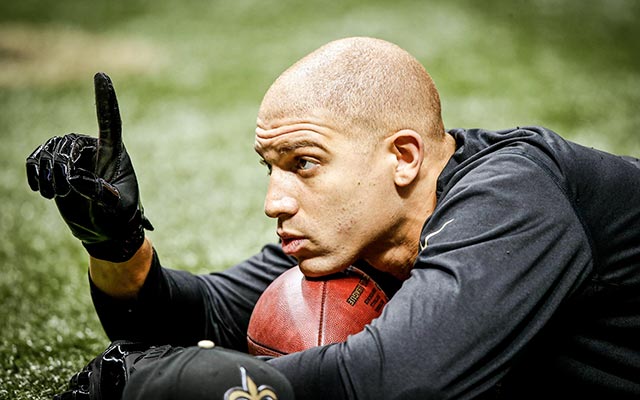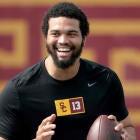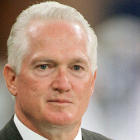
More NFL offseason: League minicamp dates | Latest news, notes
A grievance hearing is scheduled for June 17-18 to determine whether Jimmy Graham should be classified as a tight end or wide receiver with the franchise tag designation he received from the New Orleans Saints.
The National Football League Players Association filed the grievance on Graham’s behalf earlier this month because the NFL’s Management Council listed him as a tight end when the Saints made their designation. Currently, Graham is counting on the team’s salary cap at the $7.053 million tight end number. The wide receiver franchise tag is $12.132 million, $5.079 million more than the tight end franchise tag.
Franchise tags are determined by the position where the player participated in the most plays during the prior season. Graham will argue that he spent more time at wide receiver last year than at tight end. According to ESPN.com, 45 percent of Graham’s snaps were in the slot, 33 percent were as an in-line tight end and 22 percent were out wide.
This isn’t the first time there’s been a grievance over a franchise tag position. In 2008, the Baltimore Ravens’ Terrell Suggs challenged his franchise player designation as a linebacker by contending he had more playing time as a defensive end. The Ravens and Suggs settled the dispute without establishing a precedent by agreeing to use the average of the defensive end and linebacker franchise tags. If the parties settled like in Suggs’ case by using the average of the tight end and wide receiver franchise tags, Graham’s number would be $9.593 million.
A hybrid number would add $2.54 million to the Saints’ salary cap, which the team can’t really afford. The Saints only have $1.935 million of salary cap space. Losing the grievance would put the Saints almost $3.15 million over the salary cap because of Graham’s franchise tag increasing to $12.132 million. The Saints would be forced to immediately release players or restructure contracts to comply with salary cap rules. The most viable restructure candidates would be Drew Brees, Jahri Evans, Ben Grubbs and Marques Colston because their respective cap numbers are $18.4 million, $11 million, $9.1 million and $8.3 million.
Based on the time frame of Brees’ grievance in 2012 to determine whether franchise tags applied across teams or were specific to teams, the arbitrator would likely render his decision about a week after the hearing. Graham and the Saints would have approximately three weeks to reach an agreement before the July 15 deadline for franchise players to sign long-term deals with their teams.
A couple of NFL teams and player agents have consistently told me that Graham wants to be paid among the top wide receivers. Calvin Johnson and Larry Fitzgerald set the wide receiver market with long term deals averaging slightly more than $16 million per year containing in excess of $45 million of guaranteed money. The second tier of wide receiver deals are in the $11 million to $12 million per year range with between $25 million and $30 million of guarantees. The Saints are reportedly ready to make Graham the NFL’s highest-paid tight end but haven’t been willing to approach the wide receiver salaries. The New England Patriots’ Rob Gronkowski is the highest-paid tight end with the six-year, $54 million contract extension (includes $18.17 million in guarantees) he signed in 2012 that has a team friendly structure. Vernon Davis sets the standard for tight ends in guarantees with $23 million.
Offer sheet possibilities
Graham’s grievance doesn’t preclude him from signing an offer sheet with another team. If he signed an offer sheet, the Saints would have five days to match the offer. If the offer wasn’t matched, the Saints would receive two first-round picks (2015 and 2016) as compensation from the signing team.
The Saints’ salary cap situation makes them vulnerable to an offer sheet. In addition to having very little salary cap room this year, the Saints have one of the worst salary cap situations for 2015. They already have slightly over $142 million in 2015 salary cap commitments (top 51 players). Only the New England Patriots ($145.488 million), Arizona Cardinals ($143.825 million) and Miami Dolphins ($143.598 million) have more 2015 salary cap obligations. The Patriots and Dolphins should be in much better shape than the Saints and the Cardinals. $20 million of cap space will be gained if the Patriots don't exercise their option for a 2015 contract year with Darrelle Revis before the end of the 2014 league year (early March 2015). The Dolphins should have a substantial amount of unused 2014 salary cap room to roll over to 2015.
An offer sheet would probably need to be front loaded with at least the first two years fully guaranteed using a “pay-as-you-go” structure while putting Graham at the top of the second salary tier for wide receivers in order to make it difficult for the Saints to match. A player’s cash and salary cap numbers are the same in each contract year where he is receiving salary guarantees instead of a signing bonus under the “pay as you go” model. Since there isn’t any signing bonus proration, the team won’t have any dead money (a cap charge for a player no longer on the roster) if a player is released during the latter years of the deal provided that his contract hasn’t been restructured. For example, fully guaranteed $13 million salaries in 2014 and 2015 for Graham would be hard for the Saints to swallow. The Saints wouldn’t be able to restructure Graham’s deal to lower his 2014 cap number with a matched offer sheet.
Although unlikely, below are the few teams with enough salary cap space to sign Graham to an offer sheet and a need at tight end.
Cleveland Browns: Although Jordan Cameron is a Pro Bowl caliber tight end, the Browns could still use more receiving options after signing injury plagued Miles Austin and Earl Bennett with Josh Gordon facing a one-year suspension. Cameron is entering the final year of his rookie deal. Offensive coordinator Kyle Shanahan would have to borrow a few concepts from when the New England Patriots were tight end centric with Gronkowski and Aaron Hernandez to maximize a Cameron/Graham tight end duo. The Browns are second in the NFL with slightly over $25 million of salary cap space
Green Bay Packers: Pursuing Graham would be an uncharacteristic move for general manager Ted Thompson given that the Packers are primarily built with homegrown talent. Thompson already made one surprising move this off-season by signing Julius Peppers once the Chicago Bears released him. The Packers make the most sense for Graham because they should be a playoff team and have a quarterback, Aaron Rodgers, who is comparable to or better than Brees. Since the Packers have slightly under $15 million of salary cap room, a couple of contracts would eventually need to be restructured with an unmatched offer sheet. The addition of Graham would likely mean that either Randall Cobb or Jordy Nelson, both entering contract years, wouldn’t be re-signed. Adding Jermichael Finley to the tight end mix on a one-year incentive laden deal once he receives medical clearance from his neck injury that required fusion surgery in November seems more plausible.
Jacksonville Jaguars: The Jaguars signed transition player Alex Mack to a five-year, $42 million offer sheet making him the NFL’s highest paid center. The Cleveland Browns quickly matched the offer. With a league leading $28.45 million of salary cap room, the Jaguars are in the best position to front load an offer sheet that the Saints couldn’t match. Marcedes Lewis, whose salary and cap number this year are $6.85 million and $8.25 million, would become expendable. Going from Brees to Chad Henne or Blake Bortles would be a big change for Graham.
New York Jets: Head coach Rex Ryan would probably be on board with using a chunk of the team’s almost $23 million in salary cap room to pursue Jimmy Graham. General manager John Idzik’s pragmatic approach to building the roster should preclude such a move. Jace Amaro was selected in the second round of this year’s draft with the 49th overall pick.
Tennessee Titans: Graham would be a big upgrade over Delanie Walker. However, Tennessee’s unsettled quarterback situation with the Titans declining to pick up the 2015 option year for 2011 first-round pick Jake Locker may not be attractive to Graham despite having approximately $19.25 million of salary cap space.
Fortunately for the Saints, teams usually are unwilling to part with two first-round picks to sign a franchise player. Joey Galloway in 2000 was the last franchise player to move to another team for full compensation when the Seattle Seahawks received two first-round picks from the Dallas Cowboys.
Typically, when players with franchise tags switch teams, it’s through a trade with less than two first-round picks received in return. The last trade of a franchise player occurred in 2009. The Kansas City Chiefs acquired quarterback Matt Cassel (and linebacker Mike Vrabel ) from the New England Patriots for a 2009 second-round pick (34th overall). A year earlier, Kansas City traded defensive end Jared Allen to the Minnesota Vikings for a first-round pick (15th overall) and two third-round picks in the 2008 NFL Draft. The teams also swapped 2008 sixth round picks.
Likely result
Just like with Brees in 2012, Graham will likely sign a long-term deal as the July 15 deadline for a long-term deal approaches. Whether it’s a deal paying Graham like a wide receiver or just making him the NFL’s highest-paid tight end could hinge on how an arbitrator views the 45 percent he spent in the slot (tight end or wide receiver). Graham would gain tremendous leverage in negotiations if he won the hearing. Even if Graham loses the hearing, he could still become the NFL’s first $10 million per year tight end and set a new benchmark in guarantees for the position. Either way, expect any long-term deal negotiated between the parties to contain a much lower 2014 cap number than Graham’s current $7.053 million tight end tender. The six-year, $52.5 million deal Jairus Byrd received from the Saints in March has a $3.5 million first year cap number.
Joel Corry is a former sports agent who helped found Premier Sports & Entertainment, a sports management firm that represents professional athletes and coaches. Before his tenure at Premier, Joel worked for Management Plus Enterprises, which represented Shaquille O'Neal, Hakeem Olajuwon and Ronnie Lott.
You can follow him on Twitter: @corryjoel
You can email him at jccorry@gmail.com




















